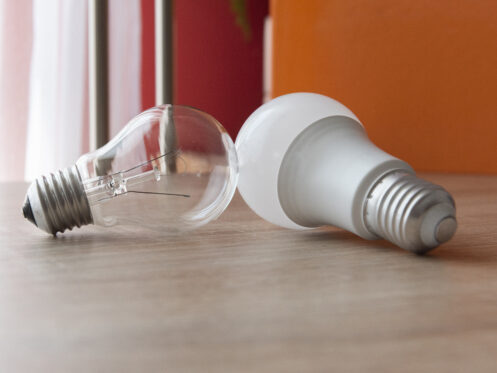LED lights offer many benefits over alternatives like compact fluorescent lighting (CFL), including their dazzling radiance and energy efficiency. That’s why many Texans are furnishing their homes, businesses, and roadways with energy-efficient LED lights. As energy concerns keep growing, continue reading to learn why LED lamps are making an impact among homeowners in Texas.
1. Greater Energy Savings
LED lights are advantageous if you want to save money on energy because they generate more useable lumens while using less energy than other light sources.
The luminous efficacy, also known as usable lumens, quantifies energy efficiency. These metrics define how much light a bulb produces with each watt of energy it uses. Thus, the more useable lumens with little energy, the more efficient the light source. Here is when LED lights thrive!
Replacing incandescent bulbs with LEDs might result in a 90% increase in efficiency. Better energy efficiency leads to higher savings. And higher energy savings translate to lower utility bills. Since for a typical household lighting accounts for 20% to 30% of the total electricity bill, you’ll save a lot of money in the long run.
2. Increased LED Lifespan
The lifespan of an LED light bulb is three to five times that of a compact fluorescent lamp (CFL) and as much as 30 times that of an incandescent bulb.
Proper usage means your lights last thousands of hours longer than competing options. You might not have to replace an LED light for years.
3. Reduced Environmental Impact
The lower energy consumption associated with LED lighting has a considerable positive impact on the environment. The International Energy Agency claims that LED lighting is the most efficient light source on the market, providing an average output of 11 lumens per watt.
4. Low Heat and UV Emissions
Most of the energy emitted by LED lights is visible, a negligible proportion is infrared, and almost none is ultraviolet. Since LED lights do not emit UV rays, they are perfect for safely lighting sensitive goods such as artwork, which could be harmed if exposed to such radiation.
LEDs produce significantly less heat when compared to other types of lighting. For instance, incandescent lighting converts 90% of its energy into heat, leaving only 10% for light production.
5. Enhanced Safety
LED lighting has environmental benefits, including improved safety for household members. Mercury can be found in the bulbs of two conventional light sources: mercury vapor lighting and fluorescent lighting. When these bulbs end their useful life, you must handle them carefully to avoid mercury exposure or discharge, which can harm your health.
Since they generate light from semiconductors, LED lights do not include mercury in their construction. LED illumination minimizes the need to be concerned about properly disposing of bulbs.
6. Versatility
LED lights are tiny, about the size of a pepper flake, making them easy to integrate into various fittings and fixtures. A skilled specialist may assist you in embedding them into thin tapes, strips, or cloth to create unique architectural or interior decor lighting schemes.
7. Directional Lighting
Traditional light sources release light in all directions surrounding the bulb, illuminating each equally. However, when you want to focus your light only on one area of your home, you may require directional lighting. Thus, you need to buy extra reflectors or redirectors to get directed lighting from an ordinary or CFL bulb.
LED lights are perfect for applications requiring directional lighting. These bulbs let forth light in a specific direction. Compared to light sources that require redirection, this attribute renders LED lights more energy-efficient.
8. Frequent Switching
It takes a few seconds for metal halide and fluorescent lights to switch on entirely. The warm-up slows your lighting and, if turned on and off frequently, degrades the light source. Suppose it’s essential for your lights to switch on immediately after a power outage. In that case, there are better options than standard light sources.
Conversely, LED lights switch on and off instantly and can tolerate repeated switching without compromising efficiency. This capability makes LEDs ideal for color-changing light installations, such as LED walls or light-flashing displays.
9. Dimming Capability
There are instances when dimming the lights may be necessary, whether for energy conservation or to set the mood for a particular occasion. Traditional light sources, such as metal halide lamps, are less efficient when dimmed and might not dim.
LED lights work well at any percent of their rated power, ranging from 5% to 100%. The energy-effectiveness of these lights is not harmed by dimness. In fact, dimming your LED lights can boost their efficiency. The dimming function of an LED light allows you to extend the life of each bulb while also saving money on energy.
10. Low-Voltage Operation
Did you know that Austin is located in a ‘flash flood alley,’ which has a higher risk of flooding than any other region in the United States? Central Texas has rocky, clay-rich soil and steep topography, making it prone to significant flooding.
Thus, having lights that work at a low voltage can be a significant advantage in this case. Low-voltage light systems can safeguard household members from electrical shocks if your home floods.
LED lights are ideal since they work at low voltages. This means that your bulbs can help safeguard members of your family who are inside in a flood.
11. Operation in Various Temperatures
Some standard lighting sources perform poorly in frigid temperatures. Incandescent lights, for example, need a greater voltage to turn on if they get too cold. This feature is not suited for illuminating cold areas such as freezers. Also, the intensity of incandescent light decreases in colder conditions, making it less efficient.
LED lights perform well in various temperatures, making them excellent for use in cold and hot environments. They are well-suited for parking lots and building perimeters.
12. Ideal Color Rendering Index (CRI)
CRI compares the ability of a light source to that of natural light to illuminate the hues of objects. Some light sources have a higher CRI than others. For instance, sodium vapor lamps feature a low CRI and generate an almost monochrome environment, washing off color nuances. On the other hand, LED lights have a high CRI, making it easier to distinguish between the colors they light.
Improve Your Property’s Lighting With LED Light Systems From Accurate Home Services
LED lighting has many benefits, including lower energy costs for your property, increased safety, and the ability to provide directional lighting that precisely highlights colors. LED lights are additionally safe, have a minimal environmental impact, and are incredibly adaptable.
At Accurate Home Services, we install visual lighting (AVL) systems, including LED lights, and solve your other electrical and HVAC issues. We work alongside you to assess your home’s needs and create an original design that reflects your vision. Contact Accurate Home Services if you need help with indoor lighting project in Kaufman, TX.




